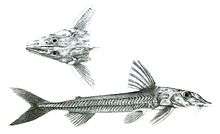Leptodoras
Leptodoras is a genus of thorny catfishes native to South America.
| Leptodoras | |
|---|---|
 | |
| Leptodoras acipenserinus | |
| Scientific classification | |
| Kingdom: | Animalia |
| Phylum: | Chordata |
| Class: | Actinopterygii |
| Order: | Siluriformes |
| Family: | Doradidae |
| Subfamily: | Doradinae |
| Genus: | Leptodoras Boulenger, 1898 |
| Type species | |
| Oxydoras acipenserinus Günther, 1868 | |
Taxonomy
Leptodoras is a monophyletic genus based on the single unique characteristic: presence of an infranuchal scute. This scute is the first in a series of well-developed midlateral scutes characteristic of most doradids.[1] It is one of the most derived genera within the clade of fimbriate-barbel doradids.[1] The most closely related genus to Leptodoras is Anduzedoras.[1]
This genus includes eleven species, making it the largest doradid genus.[1] There has been taxonomic confusion due to similarities of some species with each other and members of other genera. Misunderstood distributions and identities of some species added to this confusion. Most species were described from small geographic areas without information on their potential distributions. Also, specimens have been rare in museums until recently.[2] An assessment in 2005 diagnosed Leptodoras and its seven species while describing three new species.[2]
Species
There are currently 12 recognized species in this genus:[3]
- Leptodoras acipenserinus (Günther, 1868)
- Leptodoras cataniai Sabaj Pérez, 2005
- Leptodoras copei (Fernández-Yépez, 1968)
- Leptodoras hasemani (Steindachner, 1915)
- Leptodoras juruensis Boulenger, 1898
- Leptodoras linnelli C. H. Eigenmann, 1912
- Leptodoras marki Birindelli & Sousa, 2010[4]
- Leptodoras myersi J. E. Böhlke, 1970
- Leptodoras nelsoni Sabaj Pérez, 2005
- Leptodoras oyakawai Birindelli, Sousa & Sabaj Pérez, 2008[1]
- Leptodoras praelongus (G. S. Myers & S. H. Weitzman, 1956)
- Leptodoras rogersae Sabaj Pérez, 2005
Distribution
Leptodoras species are distributed in large, predominantly lowland rivers east of the Andes throughout the northern half of South America.[2] Species are distributed throughout lowlands in the Orinoco, Amazon, and Tocantins basins and several coastal river systems that enter the Atlantic between the mouths of the Orinoco and Amazon. Leptodoras is not known from west-Andean drainages or Atlantic-slope drainages south of the Tocantins.[2]
Description
Leptodoras is easily recognized by its long conical snout and well-developed oral hood formed by the membranous union of maxillary barbels, paired jaw barbels on the chin, and lip structures.[2] It has fimbriate barbels.
Ecology
Most species of Leptodoras are truly benthic and typically inhabit the deep swift-flowing waters of large rivers. Many species of Leptodoras migrate at dusk into shallow waters near shore to forage over beaches and shoals of sand or silt. Other species, such as L. juruensis and L. myersi, appear more restricted to deep channel habitats. Leptodoras species are not known from elevations exceeding 500 metres (1600 ft) above sea level and most records are from below 200 m (660 ft).[2]
The oral hood found in Leptodoras species presumably facilitates the detection and suction-feeding of shallowly buried invertebrates. Stomach contents typically include chironomid larvae, sand, and detritus.[2]
References
- Birindelli, José L. O.; Sousa, Leandro M.; Sabaj Pérez, Mark H. (2008). "New species of thorny catfish, genus Leptodoras Boulenger (Siluriformes: Doradidae), from Tapajós and Xingu basins, Brazil". Neotropical Ichthyology. 6 (3): 465–480. doi:10.1590/S1679-62252008000300020.
- Sabaj, Mark Henry (2005). "Taxonomic assessment of Leptodoras (Siluriformes: Doradidae) with descriptions of three new species" (PDF). Neotropical Ichthyology. 3 (4): 637–678. doi:10.1590/S1679-62252005000400020. Archived from the original (PDF) on 2007-06-30. Retrieved 2007-06-18.
- Froese, Rainer and Pauly, Daniel, eds. (2011). Species of Leptodoras in FishBase. December 2011 version.
- Birindelli, José L. O.; Sousa, Leandro M. (2010). "New Species of the Thorny Catfish Genus Leptodoras (Siluriformes: Doradidae) from Rio Fresco, Xingu Basin, Brazil". Copeia. 2010 (2): 292–299. doi:10.1643/CI-09-153.